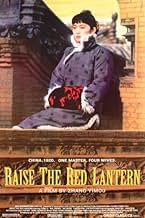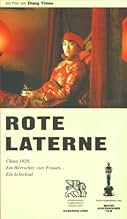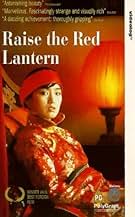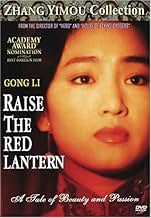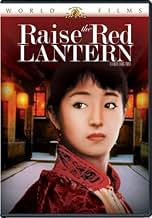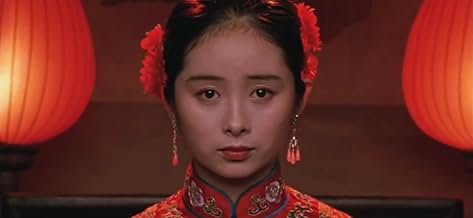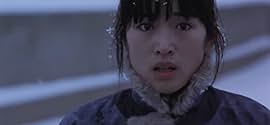IMDb-BEWERTUNG
8,1/10
36.992
IHRE BEWERTUNG
Eine junge Frau wird die vierte Ehefrau eines wohlhabenden Mannes und muss lernen, mit den strengen Regeln und Spannungen innerhalb des Haushalts zu leben.Eine junge Frau wird die vierte Ehefrau eines wohlhabenden Mannes und muss lernen, mit den strengen Regeln und Spannungen innerhalb des Haushalts zu leben.Eine junge Frau wird die vierte Ehefrau eines wohlhabenden Mannes und muss lernen, mit den strengen Regeln und Spannungen innerhalb des Haushalts zu leben.
- Für 1 Oscar nominiert
- 23 Gewinne & 15 Nominierungen insgesamt
Weimin Ding
- Songlian's Mother
- (Synchronisation)
Zengyin Cao
- Old Servant
- (as Zhengyin Cao)
Zhigang Cui
- Dr. Gao
- (as Zhihgang Cui)
Espérance Pham Thai Lan
- Kids - Concubines
- (Nicht genannt)
Empfohlene Bewertungen
Just another, in a very, very long list of films that document the abuses and misery suffered by women - this time in 1920s China but take a decade of any country and you'll find a plethora of these films. It's a shame that such a huge amount of material exists in the first place, let alone that it continues to this day. That said, the visuals are spectacular, the acting sublime, it is a beautiful thing to behold and the message is well and truly received and understood: we know who is in charge!
I can certainly understand why this film is so critically acclaimed. Raise The Red Lantern is one of the only Chinese movies I've seen, but I'll definitely admit that it's unusual to see a film this stylistically masterful come out of Hollywood (although it can happen -- The Thin Red Line, for example). A lot of what makes this film work is Zhang Yimou's outstanding directorial style; his use of color against bleak background is especially effective. It's his hypnotic visuals that keep you interested throughout the slow progression of the story. And the amazing acting by most of the performers doesn't hurt, either; everything feels completely real.
I think of this as one of those movies that you aren't supposed to enjoy; it shocks you, and leaves you just as disturbed as, considering the subject matter, you should be. The miserable story of Yan'er, the servant girl, is especially painful to watch, and the same goes for the unfolding of the last few scenes. But I think the fact that I was so unsettled by this movie probably just goes to show how well it gets its points across. And along with the remarkable acting and directing, that's definitely something to be respected.
I think of this as one of those movies that you aren't supposed to enjoy; it shocks you, and leaves you just as disturbed as, considering the subject matter, you should be. The miserable story of Yan'er, the servant girl, is especially painful to watch, and the same goes for the unfolding of the last few scenes. But I think the fact that I was so unsettled by this movie probably just goes to show how well it gets its points across. And along with the remarkable acting and directing, that's definitely something to be respected.
I had a good day, so I selected this film. I have several films that I reserve for good days because I know they will reward. Its a sort of celebration that will send me into rich dreams, annotating my life.
This has two known qualities that you, dear reader, can expect without knowing anything about the film itself.
First, you will know that this is a woman directed by someone deeply in love with her. This doesn't always produce great films, but when the director is inherently cinematic, it often evokes something deep in the viewer. There is nothing in the world like looking on the face the person you are centered on. A million subtle decisions are made in each scene, summing to an effect that cannot be missed. If this had poor narrative qualities (and some of their films did) it would still have this quality of seeing into a soulmate deeply enough to be able to animate the skin.
Its quite interesting when you consider the woman. If you see her outside of film, or in films made by ordinary eyes, she is quite ordinary. She has an atypical Chinese body: busty and widehipped. She is poised but doesn't have the neck or cheekboned face of other Asian women. Only under this man's eye is she a goddess. You can see this in the very first shot.
The second thing you can count on is the architectural anchoring of the thing. This man knows how to use space. He uses it in the cinematic narrative, for example, if you replay the shots where the house of death is shown, and then the last encounter with it... And if you understand why the decisions about handling distance and surfaces were made they way they were, you will have entered a zone where from now on you will not be able to reason without reasoning with place.
But there are other handlings of space: As with some of his other films, the building is a character. Its the noir narrator who sets the rules often arbitrary under which all characters are bound to operate, and which drives the narrative. Its a particularly western notion, this, and has gotten our hero in trouble, even banned. This part is following Welles and Kubrick.
But he goes further than either of them with this notion that the light both has agency of its own (it selects which of the four wives gets a foot massage and sex) and is a part of the fabric of the buildings. The redness changes the spaces it occupies, bringing intrigue with the sex, desire for several things. Its quite layered, what is going on. These lanterns are the real master; in fact the person who inhabits the master's body is hardly even there. We never see his face.
Because of the extensive use of hard planes and selfish light, there aren't many fabric effects here, as we'll see elsewhere.
I am tempted to designate this as one of my two allowed "must see before you die" films of 1991. But I'm in too good a mood to make such a serious decision.
Ted's Evaluation -- 3 of 3: Worth watching.
This has two known qualities that you, dear reader, can expect without knowing anything about the film itself.
First, you will know that this is a woman directed by someone deeply in love with her. This doesn't always produce great films, but when the director is inherently cinematic, it often evokes something deep in the viewer. There is nothing in the world like looking on the face the person you are centered on. A million subtle decisions are made in each scene, summing to an effect that cannot be missed. If this had poor narrative qualities (and some of their films did) it would still have this quality of seeing into a soulmate deeply enough to be able to animate the skin.
Its quite interesting when you consider the woman. If you see her outside of film, or in films made by ordinary eyes, she is quite ordinary. She has an atypical Chinese body: busty and widehipped. She is poised but doesn't have the neck or cheekboned face of other Asian women. Only under this man's eye is she a goddess. You can see this in the very first shot.
The second thing you can count on is the architectural anchoring of the thing. This man knows how to use space. He uses it in the cinematic narrative, for example, if you replay the shots where the house of death is shown, and then the last encounter with it... And if you understand why the decisions about handling distance and surfaces were made they way they were, you will have entered a zone where from now on you will not be able to reason without reasoning with place.
But there are other handlings of space: As with some of his other films, the building is a character. Its the noir narrator who sets the rules often arbitrary under which all characters are bound to operate, and which drives the narrative. Its a particularly western notion, this, and has gotten our hero in trouble, even banned. This part is following Welles and Kubrick.
But he goes further than either of them with this notion that the light both has agency of its own (it selects which of the four wives gets a foot massage and sex) and is a part of the fabric of the buildings. The redness changes the spaces it occupies, bringing intrigue with the sex, desire for several things. Its quite layered, what is going on. These lanterns are the real master; in fact the person who inhabits the master's body is hardly even there. We never see his face.
Because of the extensive use of hard planes and selfish light, there aren't many fabric effects here, as we'll see elsewhere.
I am tempted to designate this as one of my two allowed "must see before you die" films of 1991. But I'm in too good a mood to make such a serious decision.
Ted's Evaluation -- 3 of 3: Worth watching.
We Americans are accustomed to our fast moving world and our equally fast paced movies but the older countries of the world have something very valuable to offer in cinema, if we can take some time, literally, to consider it. This movie brings that mature stateliness of the old world before our eyes in almost an indelible way.
Moving in a very slow and artfully calculated rhythm, one scene slides into another, each setting a perfect little painting that can almost distract the attention away from the action and the dialog. The story develops gradually, starting out as a situation that is completely unfamiliar to the viewer and progressing stepwise through increasingly familiar emotional territory until even the 21st century American knows exactly where things stand.
The story is absorbing and the comment on Chinese society is important in today's world, but the main interest for me is the mood of meditative quietude and the rather dreamlike atmosphere that is generated continually, until it saturates right through.
Moving in a very slow and artfully calculated rhythm, one scene slides into another, each setting a perfect little painting that can almost distract the attention away from the action and the dialog. The story develops gradually, starting out as a situation that is completely unfamiliar to the viewer and progressing stepwise through increasingly familiar emotional territory until even the 21st century American knows exactly where things stand.
The story is absorbing and the comment on Chinese society is important in today's world, but the main interest for me is the mood of meditative quietude and the rather dreamlike atmosphere that is generated continually, until it saturates right through.
This movie has it all, betrayal, conflict and tragedy. I have to say that I couldn't live without it, effectively anyway. The political criticisms tear at the spine of the film and the beauty of it in such an intimate setting is outstanding. The use of such a rich, three dimensional setting defies what we have been taught by the mainstream as being beautiful and sets a standard on a budget that I would love to be aware of, that all Hollywood movies should aspire to. It shows us that film, real film that is, does not need $100 million to look good, rather the combination of a haunting setting in the middle of vastness and the equally haunting beauty of it's star, Gong Li, but at it's heart the house itself resembles a claustrophobic pot, boiling over the surface.
This is in my opinion, Zhang Yimou's greatest film, it is a triumph in film form and narrative. The haunting sounds of flutes, a significant visual and audio element that has a mythical quality due to it's importance to Songlian and becomes an unattainable item of the gods when it is removed from existence when it is burned, becoming a tragic reminder on the attempts to vanquish the personalities of not only Songlian but all of the concubines. It's slow burning nature may repel the masses but anyone who can get a copy, do so without fail, you will never regret it. I cannot stress the importance of this film, we may see it as a study on the oppression of women in China, but this is universal, we westerners once did the same thing not too long ago.
For me the cinematography is what sells the film, it is the best I have ever seen and ever will. If there is ever a film to promote the use of the three strip technicolour process once again, this is it. Long after you have finished your post film analysis, the light from the red lanterns will still be searing in your eyes.
This is in my opinion, Zhang Yimou's greatest film, it is a triumph in film form and narrative. The haunting sounds of flutes, a significant visual and audio element that has a mythical quality due to it's importance to Songlian and becomes an unattainable item of the gods when it is removed from existence when it is burned, becoming a tragic reminder on the attempts to vanquish the personalities of not only Songlian but all of the concubines. It's slow burning nature may repel the masses but anyone who can get a copy, do so without fail, you will never regret it. I cannot stress the importance of this film, we may see it as a study on the oppression of women in China, but this is universal, we westerners once did the same thing not too long ago.
For me the cinematography is what sells the film, it is the best I have ever seen and ever will. If there is ever a film to promote the use of the three strip technicolour process once again, this is it. Long after you have finished your post film analysis, the light from the red lanterns will still be searing in your eyes.
Wusstest du schon
- WissenswertesFilmed at the Qiao Family Compound near the city of Pingyao. The complex is now open for tours, however, nowhere is there any mention of the film.
- PatzerAround 01:18:59, there is a lot of smoke in front of the third wife. And there is almost no smoke in front of the second one.
- Zitate
The Third Concubine: Good or bad, it's all playacting. If you act well, you can fool other people; if you do it badly, you can only fool yourself, and when you can't even fool yourself, you just can fool the ghosts.
Top-Auswahl
Melde dich zum Bewerten an und greife auf die Watchlist für personalisierte Empfehlungen zu.
- How long is Raise the Red Lantern?Powered by Alexa
Details
Box Office
- Bruttoertrag in den USA und Kanada
- 2.603.061 $
- Eröffnungswochenende in den USA und in Kanada
- 22.554 $
- 15. März 1992
- Weltweiter Bruttoertrag
- 2.603.061 $
- Laufzeit
- 2 Std. 5 Min.(125 min)
- Farbe
- Seitenverhältnis
- 1.85 : 1
Zu dieser Seite beitragen
Bearbeitung vorschlagen oder fehlenden Inhalt hinzufügen



